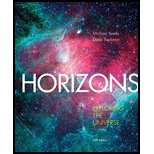
Horizons: Exploring the Universe (MindTap Course List)
14th Edition
ISBN: 9781305960961
Author: Michael A. Seeds, Dana Backman
Publisher: Cengage Learning
expand_more
expand_more
format_list_bulleted
Textbook Question
Chapter 3, Problem 8RQ
Why have most people seen a total lunar eclipse, while few have seen a total solar eclipse?
Expert Solution & Answer
Trending nowThis is a popular solution!

Students have asked these similar questions
3.63 • Leaping the River II. A physics professor did daredevil
stunts in his spare time. His last stunt was an attempt to jump across
a river on a motorcycle (Fig. P3.63). The takeoff ramp was inclined at
53.0°, the river was 40.0 m wide, and the far bank was 15.0 m lower
than the top of the ramp. The river itself was 100 m below the ramp.
Ignore air resistance. (a) What should his speed have been at the top of
the ramp to have just made it to the edge of the far bank? (b) If his speed
was only half the value found in part (a), where did he land?
Figure P3.63
53.0°
100 m
40.0 m→
15.0 m
Please solve and answer the question correctly please. Thank you!!
You throw a small rock straight up from the edge of a highway bridge that crosses a river. The rock passes you on its way down, 5.00 s after it was thrown. What is the speed of the rock just before it reaches the water 25.0 m below the point where the rock left your hand? Ignore air resistance.
Chapter 3 Solutions
Horizons: Exploring the Universe (MindTap Course List)
Ch. 3 - What is the difference between the daily and...Ch. 3 - If Earth did not rotate, could you still define...Ch. 3 - What would the seasons be like if Earth were...Ch. 3 - Why are the seasons reversed in the Southern...Ch. 3 - Prob. 5RQCh. 3 - Do the phases of the Moon look the same from every...Ch. 3 - What phase would Earth be in if you were on the...Ch. 3 - Why have most people seen a total lunar eclipse,...Ch. 3 - Why isn’t there an eclipse at every new moon and...Ch. 3 - Why is the Moon red during a total lunar eclipse?
Ch. 3 - Why should the eccentricity of Earth’s orbit make...Ch. 3 - Prob. 12RQCh. 3 - Prob. 13RQCh. 3 - How Do We know? Why must a scientific argument...Ch. 3 - You are packing for a vacation on a planet...Ch. 3 - You happen to visit the Moon when some people on...Ch. 3 - Given that Earth is about 4.6 billion (4.6109)...Ch. 3 - Identify the phases of the Moon if on March 20 the...Ch. 3 - Identify the phases of the Moon if at sunset in...Ch. 3 - Prob. 4PCh. 3 - Draw a diagram showing Earth, the Moon, and...Ch. 3 - Phobos, one of the moons of Mars, is about 25 km...Ch. 3 - A total eclipse of the Sun was visible from Canada...Ch. 3 - Prob. 8PCh. 3 - The cartoon in Figure UN 3-4 shows a crescent...Ch. 3 - The photo in Figure UN 3-5 shows the annular...
Knowledge Booster
Learn more about
Need a deep-dive on the concept behind this application? Look no further. Learn more about this topic, physics and related others by exploring similar questions and additional content below.Similar questions
- Help me make a visualize experimental setup using a word document. For the theory below.arrow_forwardHow to solve this, given answerarrow_forwardThree point-like charges are placed at the corners of a square as shown in the figure, 28.0 cm on each side. Find the minimum amount of work required by an external force to move the charge q1 to infinity. Let q1=-2.10 μC, q2=+2.40 μС, q3=+3.60 μC.arrow_forward
- A point charge of -4.00 nC is at the origin, and a second point charge of 6.00 nC is on the x axis at x= 0.820 mm . Find the magnitude and direction of the electric field at each of the following points on the x axis. x2 = 19.0 cmarrow_forwardFour point-like charges are placed as shown in the figure, three of them are at the corners and one at the center of a square, 36.0 cm on each side. What is the electric potential at the empty corner? Let q1=q3=+26.0 µС, q2=-28.0 μC, and q4=-48.0μc Varrow_forwardPLS HELparrow_forward
arrow_back_ios
SEE MORE QUESTIONS
arrow_forward_ios
Recommended textbooks for you
 AstronomyPhysicsISBN:9781938168284Author:Andrew Fraknoi; David Morrison; Sidney C. WolffPublisher:OpenStax
AstronomyPhysicsISBN:9781938168284Author:Andrew Fraknoi; David Morrison; Sidney C. WolffPublisher:OpenStax Stars and Galaxies (MindTap Course List)PhysicsISBN:9781337399944Author:Michael A. SeedsPublisher:Cengage Learning
Stars and Galaxies (MindTap Course List)PhysicsISBN:9781337399944Author:Michael A. SeedsPublisher:Cengage Learning An Introduction to Physical SciencePhysicsISBN:9781305079137Author:James Shipman, Jerry D. Wilson, Charles A. Higgins, Omar TorresPublisher:Cengage Learning
An Introduction to Physical SciencePhysicsISBN:9781305079137Author:James Shipman, Jerry D. Wilson, Charles A. Higgins, Omar TorresPublisher:Cengage Learning Foundations of Astronomy (MindTap Course List)PhysicsISBN:9781337399920Author:Michael A. Seeds, Dana BackmanPublisher:Cengage Learning
Foundations of Astronomy (MindTap Course List)PhysicsISBN:9781337399920Author:Michael A. Seeds, Dana BackmanPublisher:Cengage Learning
 Stars and GalaxiesPhysicsISBN:9781305120785Author:Michael A. Seeds, Dana BackmanPublisher:Cengage Learning
Stars and GalaxiesPhysicsISBN:9781305120785Author:Michael A. Seeds, Dana BackmanPublisher:Cengage Learning

Astronomy
Physics
ISBN:9781938168284
Author:Andrew Fraknoi; David Morrison; Sidney C. Wolff
Publisher:OpenStax

Stars and Galaxies (MindTap Course List)
Physics
ISBN:9781337399944
Author:Michael A. Seeds
Publisher:Cengage Learning

An Introduction to Physical Science
Physics
ISBN:9781305079137
Author:James Shipman, Jerry D. Wilson, Charles A. Higgins, Omar Torres
Publisher:Cengage Learning

Foundations of Astronomy (MindTap Course List)
Physics
ISBN:9781337399920
Author:Michael A. Seeds, Dana Backman
Publisher:Cengage Learning


Stars and Galaxies
Physics
ISBN:9781305120785
Author:Michael A. Seeds, Dana Backman
Publisher:Cengage Learning
Time Dilation - Einstein's Theory Of Relativity Explained!; Author: Science ABC;https://www.youtube.com/watch?v=yuD34tEpRFw;License: Standard YouTube License, CC-BY